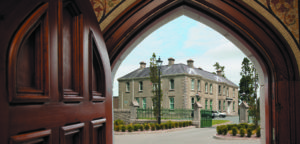MASS OF WELCOME
WORLD YOUTH DAY CROSS
ST PATRICK’S CATHEDRAL, ARMAGH
13 NOVEMBER, 2003
HOMILY BY
MOST REVEREND SEÁN BRADY
ARCHBISHOP OF ARMAGH
There is a story told of a crowd of students who were coming home from an night of partying and revelling. Their drunken leader noticed on the steeple of a church, a cross, lit up by the moonlight. He shouted, “Ye mathematicians, look at God’s plus sign”. One of the students could not sleep that night.
Towards morning he stepped into the leader’s room to tell him that the vision of the Cross, as God’s plus sign, had made him decide to uphold that Cross as the symbol of God’s abundant love for human kind. Seven other university men very soon took the same step.
The Cross has that sort of power; that is why it is a joy to welcome the World Youth Day Cross here to St Patrick’s Cathedral, Armagh. This Cross is also known as the Holy Year Cross – the Jubilee Cross – the Pilgrim Cross.
I have met and seen this Cross before – in Rome in the Jubilee Year of 2000 and in Paris in 1997 at the Twelfth World Youth Day. It was during the Holy Year of the Redemption, 1983, that Pope John Paul II felt that there should be a Cross, the symbol of our faith, near the main altar in St Peter’s Basilica. There it could be seen by everyone. And so this large wooden Cross, 3.8 meters high, was placed there according to the Holy Father’s desire.
At the end of that Holy Year the Pope entrusted this Cross to the youth of the world. He said,
“My dear young people…… I entrust to you the sign of this Jubilee, the Cross of Christ. Carry it throughout the world as a symbol of Christ’s love for humanity. Announce to everyone that only in the death and resurrection of Christ can we find salvation and redemption”. (Rome 22 April 1984).
Only by being united to Christ, crucified on the Cross, can we be saved and set free.
The young people responded magnificently to the Holy Father’s request. And for the next three years they took it to Munich, in Germany, Lourdes, Paray-le-Monial, Prague and several other countries. In 1986 the Cross was present in Rome for the celebration of the First World Youth Day. I remember the preparation ceremonies which took place outside the Basilica of St John Lateran, the Pope’s Cathedral, within sight of the Basilica of the Holy Cross. This is a church built by the Helena, mother of Constantine to house the Relics of the true Cross which she brought from the Holy Land. I remember well the young people walking from St John Lateran’s to St Paul’s, outside the walls, to the spot which marks the burial place of St Paul. There, a memorable prayer vigil took place. Confessions went on late into the night and the early hours of the morning. At dawn a band of young people set out to carry the Cross, on their shoulders, along the banks of the Tiber up to St Peter’s Basilica for the first World Youth Day 1986.
Since then the Cross has literally ‘gone around the world’. In 1987 to Buenos Aires in Argentina, the first time it went to the American continent. In 1988 the Cross travelled to Germany and France and across the Atlantic again to the United States. In 1989 it went to the Fourth World Youth Day, which was being held in Santiago de Compostela in Spain and in October of that year it made its first visit to Asia where it was present at an International Eucharistic Congress in Korea. Following a visit to Canada where it was transported by dog sleigh, it travelled to the Philippines and around the various islands by boat. In New York it made a special visit to Ground Zero in the aftermath of September 11. In the year of the Great Jubilee in Rome the Cross was carried along the Way of the Cross through the Roman Forum to the Coliseum. What is the purpose of it all you may ask?
Let’s listen again to the Holy Father:
“The pilgrim Cross passes from one continent to another, and young people everywhere come together to witness together that Jesus Christ is the same for each one, and that his message is always the same. In him there are no divisions, no ethnic rivalry, no social discrimination. All are brothers and sisters in the family of God.”
On Palm Sunday this year the Pope introduced a new element. Henceforth, the Cross will be accompanied, on its pilgrimage, by the Icon of Our Lady, Salus Populi Romani – Salvation of the People of Rome – The Holy Father went on to say:
“Today I also entrust the Icon of Mary. From now on it will accompany the World Youth Days, together with the Cross. Behold, your Mother! It will be a sign of Mary’s motherly presence close to young people who are called, like the Apostle John, to welcome her into their lives.” (Angelus, 18th World Youth Day, 13 April 2003).
Mary watched her son die on Calvary. No parent expects to see their child die. But Mary did not run away, she stood at the foot of the cross, inconsolable in her grief, inspirational in her example.
Throughout its journeys and pilgrimages, young people have come to touch the Cross, to embrace it, and to pray fervently. There have been many testimonies from people who have been touched by their contact with the Cross. These have become more numerous in recent years, or maybe they have just become more publicised, thanks to the Internet.
People sometimes ask how two pieces of wood can have such an effect on a person’s life. Wherever it travels, the people ask if it can return again. They see a symbol of the presence and love of God in that Cross. Through it, many young people come to a better understanding of the Resurrection, and some find that it gives them courage to make decisions about the course their life should take. One of the young people from Canada had this to say:
“This cross has had a tremendous impact on all of the nations where it has been present. This was evident to me during the ceremonies when we received the cross from the Italians. They were extremely emotional, crying tears of sorrow because they did not want to give it up. We, on the other hand, were crying tears of joy because we were receiving a powerful symbol that we know will impact our nation.”
This evening we welcome the Cross and the Icon to Armagh where it is on pilgrimage to Cologne in Germany for the 2005 World Youth Day. I wish to refer to the logo which has been devised for the 2005 Youth Day which we can make our own this evening. It is a composition of a Cross – a star, a comet’s tail, a twin-spired Cathedral, not unlike our own and the sky.
The encounter with Christ is represented by the Cross which dominates the logo. It is Christ’s presence that brings us here this evening. The colour red symbolises the love, passion and the pain. It indicates God’s love and Jesus’ death on the Cross, but reminds us of the pain present in our lives and all over the world. The Cross is the main symbol of Christian hope and of redemption in Jesus, which is greater than pain.
Young people also know pain. “You’re young and have no worries”, is not always the case. You know the pain of broken relationships, sometimes of family strife, confrontation with parents and teacher, of being misunderstood, of failing, of feeling cheated or hard done by. We are also conscious of the way we all unnecessarily and sometimes unintentionally hurt one another over matters which are not important. This brokenness we bring to the Lord this evening.
The star of the logo symbolises divine guidance. It provides a sense of direction. It shines as the divine indication of the place in which Jesus was born. According to the Bible, it showed the wise men from the East, the Three Magi, the road they should travel to reach Jesus. After wandering for a long time, they encountered Jesus and returned home changed men. Just as it shone then, on the stable in Bethlehem, today the star shines on God’s house in Armagh. The star wishes to lead the young from all over the world to the Lord. We rejoice that is has led us here this evening and we open our treasures to the Lord – not gold and frankincense but our love and commitment.
The comet’s tail represents the star’s route: it comes from above, from God. Hence, it crosses the limited horizon of our earthly world. The golden colour is a reminder of God’s heavenly light, which lights up the darkness of this world.
The twin-spired Cathedral represents Cologne Cathedral, but also our own. Indeed anywhere or any space where two or three persons gather in the name of the Lord. For centuries, the relics of the Three Wise Men have been venerated in Cologne cathedral. The Cathedral’s red colouring unites the Church with the Cross: Christ and the Church are inseparable. It is through the Church that Christ, Crucified and Risen, is present in the history of the world.
The stylised letter C of the logo stands for Christ, but also for Church and Communion. The arc, which it forms, represents God’s protective embrace. The sky, representing God’s mercy, embraces and saves the Church and the whole world. This idea is also expressed by the arc’s blue colouring. The arc is projected towards the cross while simultaneously opening to it. The Logo’s global dynamics derive from the Cross:
Christians must turn to the Cross, young people too must orienate themselves towards Jesus, Crucified and Risen, in adoration, as one can read in the motto for the 2005 World Youth Day: “We have come to worship Him” (Mt, 2, 2).
I hope many of you will have the opportunity to travel to Germany the year after next. In the meantime, however, we worship the Lord this evening. He undoubtedly is very glad that we have come together in his name. We commit ourselves anew to him and to one another in brotherly and sisterly love. We remember that He is our real and only hope. The world with its inviting bright lights and designer labels cannot satisfy. Only the Lord satisfies in the long term. He is our sure hope and foundation. In him we rejoice.



You must be logged in to post a comment.